This is a list of castles, fortresses and towers in Greece .
This is a list of castles, fortresses and towers in Greece .
| Name | Location | Era | Image |
|---|---|---|---|
| Acrocorinth | Corinth | Ancient/Byzantine period |  |
| Acronauplia | Nafplion | Ancient/Byzantine/Frankish/Venetian period |  |
| Agios Georgios Castle | Cephalonia | Byzantine/Venetian period |  |
| Agios Andreas Castle | Preveza | Ottoman/Venetian period |  |
| Agios Georgios Castle | Preveza | Ottoman period |  |
| Amfissa Castle | Amfissa | Ancient/Byzantine/Frankish period | |
| Angelokastro (Corfu) | Corfu | Byzantine/Venetian periods |  |
| Anthousa Castle | Anthousa, Preveza (regional unit) | Ottoman period | |
| Anthimachia Castle | Kos | Byzantine period |  |
| Aptera Fortress | Chania | Ottoman period |  |
| Araklovon Castle [1] | Minthi, Elis | Byzantine period | |
| Arkessini Castle | Acropolis of Arkessini, Amorgos | Ancient period |  |
| Arta Castle | Arta | Byzantine period |  |
| Asini Castle | Asini, Argolis | Ancient period |  |
| Assos Castle | Assos, Cephalonia | Venetian period |  |
| Arkadia Castle | Kyparissia | Frankish period |  |
| Astypalaia Castle | Astypalaia | Frankish/Venetian period |  |
| Castle of Bouka | Preveza | Ottoman & Venetian periods |  |
| Bourtzi | Nafplio | Venetian period |  |
| Bourtzi (Karystos) | Karystos | Venetian period |  |
| Castle of Chalkis (Karababa) | Chalkis | Ottoman period |  |
| Castle of Chios | Chios | Genoese period |  |
| Castle of Mytilene | Mytilene | Ancient/Byzantine/Genoese period |  |
| Chlemoutsi | northwestern Elis | Frankish period |  |
| Castle of Cuppa | Avlonari | Frankish/Venetian period | |
| Cythera Castle | Cythera (island) | Venetian period |  |
| Didymoteicho Fortress | Didymoteicho | Ancient/Byzantine period |  |
| Elea Castle | Elea, Thesprotia | Ancient period | |
| Eleutherae | Attica | Ancient period |  |
| Esphigmenou Monastery-fortress | Mount Athos | Byzantine period |  |
| Exomvourgo Fortress | Exomvourgo, Tinos | Venetian period |  |
| Firkas Fortress (Revellino) | Chania | Ottoman period | 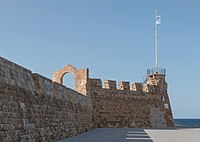 |
| Fortezza of Rethymno | Rethymno, Crete | Venetian period |  |
| Fortifications of Chania | Chania | Venetian period |  |
| Fortifications of Heraklion | Heraklion | Venetian period | 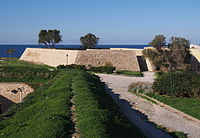 |
| Fotodotis monastery-fortress | Naxos | Byzantine period |  |
| Frangokastello | South Crete | Venetian period |  |
| Fyli Castle | Fyli | Ancient period | |
| Gardiki Castle | southwestern Corfu | Byzantine/Venetian period |  |
| Geraki Castle | Laconia | Frankish period | |
| Glarentza Castle | northwestern Elis | Frankish period | |
| Goulas Castle | Akrotiri (prehistoric city) | Venetian period |  |
| Gramvousa Castle | Gramvousa | Venetian period |  |
| Heptapyrgion | Thessaloniki | Byzantine/Ottoman period |  |
| Kales Castle | Ierapetra, Crete | Venetian period |  |
| Ioannina Castle | Ioannina | Byzantine/Ottoman period |  |
| Itzedin Fortress | Souda Bay | Ottoman period |  |
| Kalamata Castle | Kalamata, Messenia | Byzantine/Venetian/Ottoman period |  |
| Kalymnos Castle | Kalymnos | Byzantine period |  |
| Karytaina Castle | Karytaina | Frankish period |  |
| Kassiopi Castle | Kassiopi, Corfu | Byzantine/Venetian period |  |
| Kastelli of Emporio | Emporio, Santorini | Venetian period |  |
| Kastelli of Pyrgos | Pyrgos Kallistis, Santorini | Venetian period |  |
| Kastellos (Kritinia) | Kritinia, Rhodes | Hospitaller period |  |
| Kavala Castle | Kavala | Byzantine period |  |
| Kazarma fortress | Sitia | Venetian period |  |
| Koroni Castle | Koroni | Venetian/Ottoman period |  |
| Koules Fortress (Rocca al Mare) | Heraklion | Venetian period |  |
| Lamia Castle | Lamia (city) | Byzantine period |  |
| Larissa Castle | Larissa, Argos | Ancient/Byzantine period |  |
| Laskara Castle | Preveza | Late Ottoman period |  |
| Leros Castle | Leros | Hospitaller period |  |
| Lindos Castle | Acropolis of Lindos | Ancient/Byzantine/Hospitaller period |  |
| Mesta fortified town | Chios | Byzantine period | |
| Methoni Castle | Methoni | Venetian/Ottoman period |  |
| Mithymna Castle | Mithymna, Lesbos | Byzantine period |  |
| Monastery of Saint John the Theologian | Patmos | Byzantine period |  |
| Monemvasia Fortress | Monemvasia | Byzantine/Venetian period |  |
| Moni Arkadiou | Arkadi, Crete | Venetian period |  |
| Moni Toplou | Lasithi, Crete | Venetian/Ottoman period |  |
| Monolithos Castle | Monolithos, Rhodes | Hospitaller period |  |
| Myrina Fortress | Myrina, Lemnos | Byzantine period |  |
| Mystras Palace | Mystras | Byzantine period |  |
| Nafpaktos Castle | Nafpaktos | Venetian period |  |
| Naxos Castle | Naxos | Venetian period |  |
| Nerantzia Castle | Kos | Knights period |  |
| New Fortress, Corfu | Corfu (city) | Venetian period |  |
| New Navarino fortress | Pylos | Ottoman period |  |
| Old Fortress, Corfu | Corfu (city) | Venetian period |  |
| Old Navarino castle | Near Pylos | Frankish period |  |
| Orchomenus (Boeotia) Castle | Orchomenus (Boeotia) | Ancient period |  |
| Palace of the Grand Master of the Knights of Rhodes | Rhodes (city) | Hospitaller/Ottoman/Italian period | 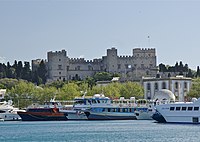 |
| Palaiokastro | Mandraki, Nisyros | Hellenistic period |  |
| Palamidi | Nafplion | Venetian period |  |
| Pantokrator Castle | Preveza | Ottoman period | |
| Parga Castle | Parga | Venetian/Ottoman period |  |
| Patras Castle | Patras | Byzantine period |  |
| Pente Pigadia Fort | Kleisoura | Ottoman period |  |
| Platamon Castle | Platamon | Frankish period |  |
| Pleuron Castle | Pleuron, Aetolia | Ancient period | |
| Potiri Castle | Avlonari | Frankish/Venetian period |  |
| Fortifications of Rhodes | Rhodes (city) | Byzantine/Hospitaller/Ottoman/Italian period |  |
| Riniasa Castle / Thomokastro | Riza, Preveza | Byzantine period | |
| Rio Castle | Rio | Ottoman/Venetian period |  |
| Rogoi/Bouchetion | Nea Kerasounta, Preveza | Ancient/Byzantine period |  |
| Saint John Castle | Archangelos, Rhodes | Hospitaller period |  |
| Santa Maura Castle | Lefkada | Venetian period |  |
| Servia castle | Kozani (regional unit) | Byzantine period | |
| Simonopetra monastery-fortress | Mount Athos | Byzantine period |  |
| Skiathos Castle | Skiathos | Byzantine period | |
| Spinalonga Castle | Spinalonga | Ancient/Venetian period |  |
| Stavronikita monastery-fortress | Mount Athos | Byzantine period |  |
| Tiryns Castle | Acropolis of Tiryns | Ancient (Mycenaean) period |  |
| Toroivia Castle | Komboti, Aetolia-Acarnania | Ancient period | |
| Trikala Castle | Trikala | Byzantine period | |
| Vonitsa Castle | Vonitsa | Byzantine/Ottoman/Venetian period |  |
| Voukation Castle | Paravola (near Agrinion) | Ancient period |  |
| Vrysoula Bastion | Preveza | Venetian/Ottoman period | |
| Walls of Thessaloniki | Thessaloniki | Byzantine period |  |
| Xenophontos monastery-fortress | Mount Athos | Byzantine period |  |
| Towers in Greece | |||
|---|---|---|---|
| Name | Location | Era | Image |
| Aigosthena Tower | Aigosthena, Attica | Ancient period | 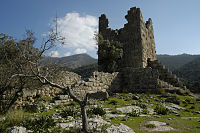 |
| Agia Tower | Naxos | Venetian period |  |
| Annunziata Tower | Corfu (city) | Venetian period |  |
| Avlonari Tower | Avlonari, Euboea | Venetian period |  |
| Belonia Tower | Naxos | Venetian period |  |
| Crispi Tower | Naxos | Venetian period |  |
| Fokea Tower | Fokea, Chalkidiki | Byzantine period | 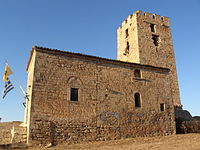 |
| Gratsia Tower | Naxos | Venetian period |  |
| Markellos Tower | Aegina | Venetian period |  |
| Maroulas Towers | Maroulas, Crete | Venetian period |  |
| Ouranoupolis Tower | Ouranoupolis, Chalkidiki | Byzantine period |  |
| Sanudo Tower | Naxos | Venetian period |  |
| Vasiliko Tower | Euboea | Venetian period |  |
| White Tower of Thessaloniki | Thessaloniki | Ottoman period |  |

Mystras or Mistras, also known in the Chronicle of the Morea as Myzethras or Myzithras (Μυζηθρᾶς), is a fortified town and a former municipality in Laconia, Peloponnese, Greece. Situated on Mt. Taygetus, above ancient Sparta, and below a Frankish castle, it served as the capital of the Byzantine Despotate of the Morea in the 14th and 15th centuries, experiencing a period of prosperity and cultural flowering during the Palaeologan Renaissance, including the teachings of Gemistos Plethon. The city also attracted artists and architects of the highest quality.

Morea was the name of the Peloponnese peninsula in southern Greece during the Middle Ages and the early modern period. The name was used for the Byzantine province known as the Despotate of the Morea, by the Ottoman Empire for the Morea Eyalet, and later by the Republic of Venice for the short-lived Kingdom of the Morea.

Lamia is a city in central Greece. The city dates back to antiquity, and is today the capital of the regional unit of Phthiotis and of the Central Greece region. According to the 2021 census, the Municipality of Lamia has a population of 66,657 while Lamia itself has 47,529 inhabitants. The city is located on the slopes of Mount Othrys, near the river Spercheios. It serves as the agricultural center of a fertile rural and livestock area.

William of Villehardouin was the fourth prince of Achaea in Frankish Greece, from 1246 to 1278. The younger son of Prince Geoffrey I, he held the Barony of Kalamata in fief during the reign of his elder brother Geoffrey II. William ruled Achaea as regent for his brother during Geoffrey's military campaigns against the Greeks of Nicaea, who were the principal enemies of his overlord, the Latin Emperor of Constantinople Baldwin II. William succeeded his childless brother in the summer of 1246. Conflicts between Nicaea and Epirus enabled him to complete the conquest of the Morea in about three years. He captured Monemvasia and built three new fortresses, forcing two previously autonomous tribes, the Tzakones and Melingoi, into submission. He participated in the unsuccessful Egyptian crusade of Louis IX of France, who rewarded him with the right to issue currency in the style of French royal coins.

Margat, also known as Marqab, is a castle near Baniyas, Syria, which was a Crusader fortress and one of the major strongholds of the Knights Hospitaller. It is located around 2 kilometres (1.2 mi) from the Mediterranean coast and approximately 6 kilometres (3.7 mi) south of Baniyas. The castle remained in a poor state of preservation until 2007 when some reconstruction and renovation began.
Grand Ma[i]gne or Vieux Ma[i]gne was a Frankish castle in the Mani Peninsula, Greece. It was built, according to the Chronicle of the Morea, ca. 1248–1250 AD by William II Villehardouin, the Prince of Achaea in order to control the Slavic tribe of the Melingoi, living on Mount Taygetos. He was captured by the Byzantines in 1259 at the Battle of Pelagonia, and had to give up the castle as part of his ransom.
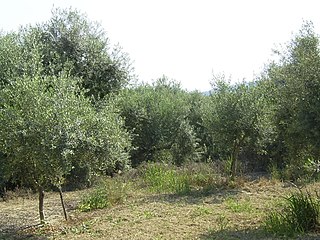
The Battle of the Olive Grove of Kountouras took place in the summer of 1205, in Messenia in the Morea peninsula, between the Frankish Crusaders and the local Byzantine Greeks, resulting in a victory of the Franks and the collapse of the local resistance.

The Frankokratia, also known as Latinokratia and, for the Venetian domains, Venetokratia or Enetokratia, was the period in Greek history after the Fourth Crusade (1204), when a number of primarily French and Italian states were established by the Partitio terrarum imperii Romaniae on the territory of the dismantled Byzantine Empire.

The Palaiologan army refers to the military forces of the Byzantine Empire under the rule of the Palaiologos dynasty, from the late 13th century to its final collapse in the mid-15th century. The army was a direct continuation of the forces of the Empire of Nicaea, which itself was a fractured component of the formidable Komnenian army of the 12th century. Under the first Palaiologan emperor, Michael VIII, the army's role took an increasingly offensive role whilst the naval forces of the empire, weakened since the days of Andronikos I Komnenos, were boosted to include thousands of skilled sailors and some 80 ships. Due to the lack of land to support the army, the empire required the use of large numbers of mercenaries.

Chlemoutsi, also known as Clermont, is a medieval castle in the northwest of the Elis regional unit in the Peloponnese peninsula of southern Greece, in the Kastro-Kyllini municipality.

The First Ottoman–Venetian War was fought between the Republic of Venice with its allies and the Ottoman Empire from 1463 to 1479. Fought shortly after the capture of Constantinople and the remnants of the Byzantine Empire by the Ottomans, it resulted in the loss of several Venetian holdings in Albania and Greece, most importantly the island of Negroponte (Euboea), which had been a Venetian protectorate for centuries. The war also saw the rapid expansion of the Ottoman navy, which became able to challenge the Venetians and the Knights Hospitaller for supremacy in the Aegean Sea. In the closing years of the war, however, the Republic managed to recoup its losses by the de facto acquisition of the Crusader Kingdom of Cyprus.

The Patras Castle was built around the mid-6th century AD above the ruins of the ancient acropolis of the city of Patras, on a low outlying hill of the Panachaiko Mountain and ca. 800 m from the sea. The castle covers 22,725 m² and consists of a triangular outer wall, strengthened by towers and gates and further protected originally by a moat, and an inner compound on the northeastern corner, also protected by a moat.

The Old Navarino castle is a 13th-century Frankish fortress near Pylos, Greece. It is one of two castles guarding the bay on which it sits; the other is the Ottoman-built New Navarino. It is frequently known simply as Palaiokastro or Paliokastro. It occupies the site of the Athenian fort at the 425 BC Battle of Pylos.

The Kingdom of the Morea or Realm of the Morea was the official name the Republic of Venice gave to the Peloponnese peninsula in Southern Greece when it was conquered from the Ottoman Empire during the Morean War in 1684–99. The Venetians tried, with considerable success, to repopulate the country and reinvigorate its agriculture and economy, but were unable to gain the allegiance of the bulk of the population, nor to secure their new possession militarily. As a result, it was lost again to the Ottomans in a brief campaign in June–September 1715.

The Barony of Akova was a medieval Frankish fiefdom of the Principality of Achaea, located in the mountains of eastern Elis in the Peloponnese peninsula in Greece, centred on the fortress of Akova or Mattegrifon. It was among the twelve original baronies of Achaea, but was conquered by the Byzantines in 1320.

The Barony of Karytaina or of Skorta was a medieval Frankish fiefdom of the Principality of Achaea, located in the Peloponnese peninsula in Greece, centred on the town of Karytaina in the mountainous region known as Skorta.

The fortress of New Navarino is an Ottoman fortification near Pylos, Greece. It is one of two castles guarding the strategic Bay of Pylos, on which it sits; New Navarino is located in the southern entrance of the bay, while the northern entrance is guarded by the 13th-century Old Navarino castle, built by the Crusaders of the Principality of Achaea. In juxtaposition with the latter, New Navarino is often known simply as Neokastro or Niokastro.

The Battle of Saint George took place on 9 September 1320 between the Latin Principality of Achaea and the forces of the Byzantine governor of Mystras, at the fortress of Saint George in Skorta in Arcadia. As a result of the battle, Arcadia, the heartland of the Morea, came firmly under Byzantine control.